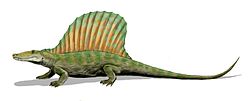Secodontosaurus
|
Secodontosaurus Temporal range: Cisuralian, 285–270.6 Ma |
|
|---|---|
 |
|
| Restoration of S. obtusidens | |
| Scientific classification | |
| Kingdom: | Animalia |
| Phylum: | Chordata |
| Family: | †Sphenacodontidae |
| Genus: |
†Secodontosaurus Romer, 1936 |
| Species | |
Secodontosaurus (meaning "cutting-tooth lizard"), an extinct genus of "pelycosaur" synapsid that lived from between about 285 to 270 million years ago during the Early Permian. Like the well known Dimetrodon, Secodontosaurus is a carnivorous member of the Eupelycosauria family Sphenacodontidae and has a similar tall dorsal sail. However, its skull is long, low, and narrow, with slender jaws that have teeth that are very similar in size and shape—unlike the shorter, deep skull of Dimetrodon ("two-measure tooth"), which has large, prominent canine-like teeth in front and smaller slicing teeth further back in its jaws. Its unusual long, narrow jaws suggest that Secodontosaurus may have been specialized for catching fish or for hunting prey that lived or hid in burrows or crevices. Although no complete skeletons are currently known, Secodontosaurus likely ranged from about 2 to 2.7 metres (7 to 9 ft) in length, weighing up to 110 kilograms (250 lb).
Fossils of Secodontosaurus have been found in Texas in North America in the Wichita and the Clear Fork groups of Early Permian formations. In recent years, teams from the Houston Museum of Natural Science have recovered remains in the Clear Fork Red Beds of North Texas that appear to be new specimens of Secodontosaurus. These discoveries are mentioned in online blogs but so far have not been formally described.
The name Secodontosaurus comes from Latin seco "to cut" + Greek odous (odont-) "tooth" + Greek sauros "lizard" and is based on the anatomical term "secodont" for teeth with cutting edges designed to tear or slice flesh. Paleontologist Robert Bakker has dubbed Secodontosaurus the "fox-faced finback" after its long jaws.
A number of partial fossil remains of Secodontosaurus have been identified from its characteristic long skull and jaws. The postcranial skeletal material from different individuals includes parts of the backbone with clear evidence of a tall sail very similar to that of Dimetrodon. The limbs and tail are incompletely known but probably resembled those of Dimetrodon as well. Like Dimetrodon, Secodontosaurus would have had a short neck, robust body, short limbs, and a long tail. In light of such similarities, some skeletal remains with missing or fragmentary skulls that were previously identified as Dimetrodon may in fact belong to Secodontosaurus. A key noncranial difference can be found in the axis neck vertebra, which has a tall and broad neural spine in Dimetrodon but has a lower neural spine in Secodontosaurus.
...
Wikipedia
